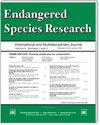Distribution and drivers of critical hibernacula for the timber rattlesnake Crotalus horridus in Illinois, USA
IF 2.9
2区 环境科学与生态学
Q2 BIODIVERSITY CONSERVATION
引用次数: 0
Abstract
ABSTRACT: The dependency on hibernacula for extended periods presents terrestrial reptiles with the challenge of locating thermally adequate hibernacula each winter. Defining the habitat characteristics of hibernacula is crucial for understanding the overwintering requirements and distributions of hibernacula-dependent reptiles, alongside identifying habitats which warrant special conservation concern. Our objectives were to identify the overwintering habitat characteristics of the imperiled timber rattlesnake Crotalus horridus in Illinois, USA, and to determine the distribution of likely hibernacula habitats throughout the state. Due to the initial sparsity of hibernacula records in Illinois, we adopted an iterative habitat suitability modeling process consisting of 3 distinct rounds of Maxent construction and revision. Each round was informed with updated information from model-guided surveys or by building rapport with in-state naturalists and researchers who knew of additional hibernacula locations. We created our final model using 36 hibernacula and identified slope angle (indicative of rock outcrops and shallow soils), topographical position index, forest patch area, and aspect (decomposed into 2 linearized variables: southness and eastness) as important drivers of C. horridus hibernacula habitat in Illinois. Together, the 5 variables and site surveys suggest the suitable overwintering habitat for C. horridus in Illinois is located on south- to southwest-facing outcrops on upper slopes and ridges of larger forest patches. Such habitat is distributed primarily in southern Illinois and throughout the Mississippi River and Illinois River border counties. Our study adds to the current understanding of the species’ overwintering requirements and provides a foundation for future ecological studies, management, and survey efforts throughout Illinois.美国伊利诺伊州 Crotalus horridus 木材响尾蛇临界冬眠地的分布和驱动因素
摘要:陆生爬行动物长期依赖冬眠地,这给它们每年冬季寻找温度适宜的冬眠地带来了挑战。确定冬眠洞穴的栖息地特征对于了解依赖冬眠洞穴的爬行动物的越冬要求和分布情况以及确定需要特别保护的栖息地至关重要。我们的目标是确定美国伊利诺伊州濒危林响尾蛇(Crotalus horridus)的越冬栖息地特征,并确定可能的冬眠栖息地在全州的分布情况。由于伊利诺伊州最初的冬眠记录较少,我们采用了一种迭代式栖息地适宜性建模方法,包括三轮不同的 Maxent 构建和修订过程。每一轮建模都参考了由模型指导的调查所获得的最新信息,或者通过与州内的自然学家和研究人员建立友好关系,他们知道更多的冬眠地点。我们利用 36 个冬眠地创建了最终模型,并确定坡角(表明岩石露头和浅层土壤)、地形位置指数、森林斑块面积和地势(分解为两个线性化变量:南向和东向)是伊利诺斯州角雉冬眠栖息地的重要驱动因素。这5个变量和现场调查共同表明,伊利诺伊州适合角马越冬的栖息地位于较大森林斑块的上坡和山脊上朝南至西南的露头处。这种栖息地主要分布在伊利诺伊州南部以及密西西比河和伊利诺伊河交界的各县。我们的研究加深了目前对该物种越冬要求的了解,并为伊利诺伊州各地未来的生态研究、管理和调查工作奠定了基础。
本文章由计算机程序翻译,如有差异,请以英文原文为准。
求助全文
约1分钟内获得全文
求助全文
来源期刊

Endangered Species Research
BIODIVERSITY CONSERVATION-
CiteScore
5.50
自引率
6.50%
发文量
38
审稿时长
31 weeks
期刊介绍:
ESR is international and interdisciplinary. It covers all endangered forms of life on Earth, the threats faced by species and their habitats and the necessary steps that must be undertaken to ensure their conservation. ESR publishes high quality contributions reporting research on all species (and habitats) of conservation concern, whether they be classified as Near Threatened or Threatened (Endangered or Vulnerable) by the International Union for the Conservation of Nature and Natural Resources (IUCN) or highlighted as part of national or regional conservation strategies. Submissions on all aspects of conservation science are welcome.
 求助内容:
求助内容: 应助结果提醒方式:
应助结果提醒方式:


